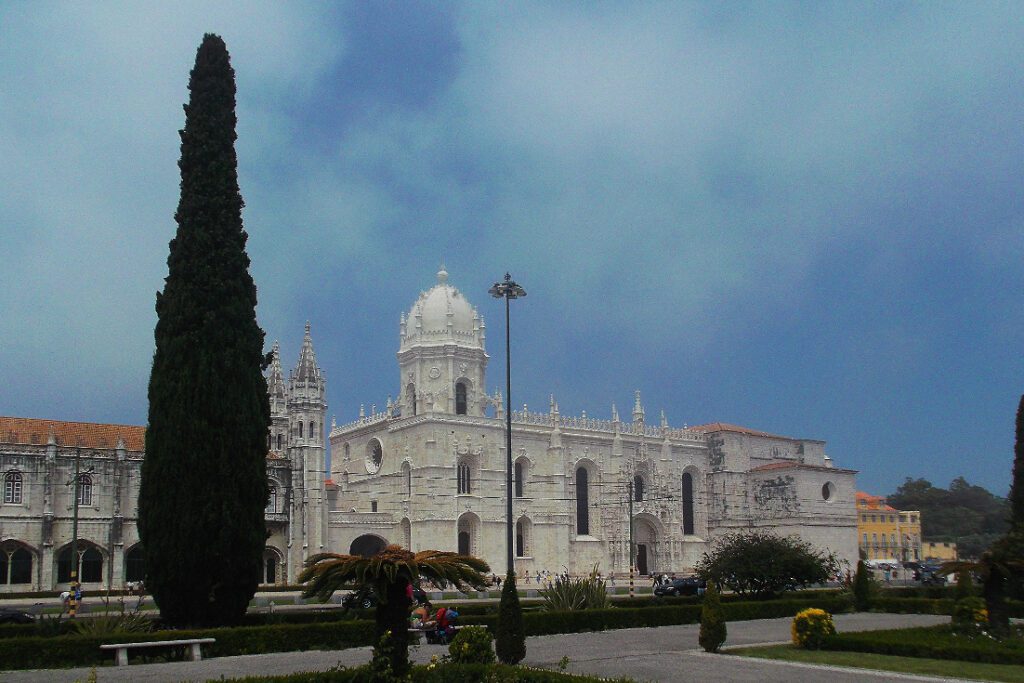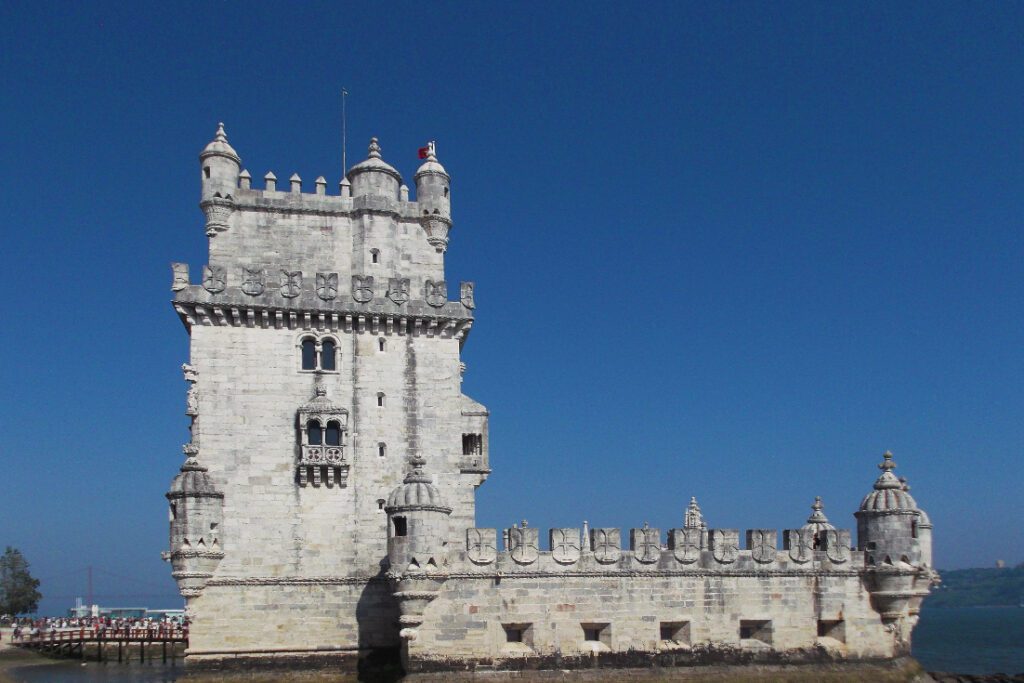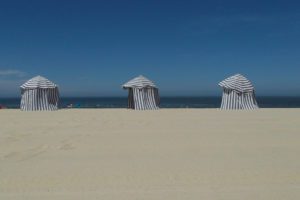Let me guide you to mesmerizing Belém – which is, technically, a suburb to Lisbon and undoubtedly the city’s treasure box.

Belém’s name is derived from the Portuguese word for Bethlehem. This most alluring part of Lisbon is as small as four square miles. Nevertheless, it is packed with all these amazingly beautiful structures and definitely a must-see when visiting Lisbon.
Nestled on the outskirts of Lisbon, Belém is a town that feels like stepping into a living postcard. Here, history, culture, and beauty collide in breathtaking harmony. With the Tagus River gently lapping at its shores, Belém exudes a regal charm that is both timeless and dynamic. The town is steeped in Portugal’s golden Age of Discovery, where intrepid explorers like Vasco da Gama set sail to chart unknown waters. Every corner of Belém whispers of maritime legacy, from the awe-inspiring Belém Tower to the grandeur of the Jerónimos Monastery. The latter is a UNESCO World Heritage site that leaves visitors speechless with its intricate Manueline architecture.
But Belém is not just a portal to the past. It’s also a vibrant hub of contemporary life. The air is filled with the aroma of freshly baked Pastéis de Belém, the iconic custard tarts that have made taste buds dance for centuries. The town is also a cultural hotspot, with cutting-edge museums like the Museum of Art, Architecture, and Technology MAAT and the Berardo Collection Museum.
Whether you’re wandering along its picturesque waterfront or sipping coffee in a charming café, Belém feels like the perfect blend of old-world charm and modern allure. It’s more than just a suburb of Lisbon—it’s a must-see destination brimming with soul, stories, and sunshine.
Left Or Right?
Depending on which side you are coming from when you arrive at the Belém station, you might first want to go to the MAAT.
As a matter of fact, you cannot cross the freeway-ish road wherever you please. However, there are two bridges and a tunnel. But nothing more. This freeway is so large that it actually consists of two roads, the Avenida Brasília and the Avenida India.
For instance, coming from Lisbon, you have to cross the road over the bridge to get to the MAAT, the Museu de Arte, Arquitetura e Tecnologia. However, coming from Estoril, you’re already on the right side.
MAAT
Museum of Art, Architecture and Technology
Avenida Brasília
1300-598 Lisboa
Phone: + 351 – 210 – 028 130
Email: maat@edp.pt
Open Wednesday to Monday from 11 a.m. to 7 p.m.
Ok, after you’ve visited the MAAT, this side of the road has nothing much to offer so cross over the bridge and stroll towards the Jardim Alfonso de Albuquerque, where Mr. de Albuquerque himself is welcoming you.
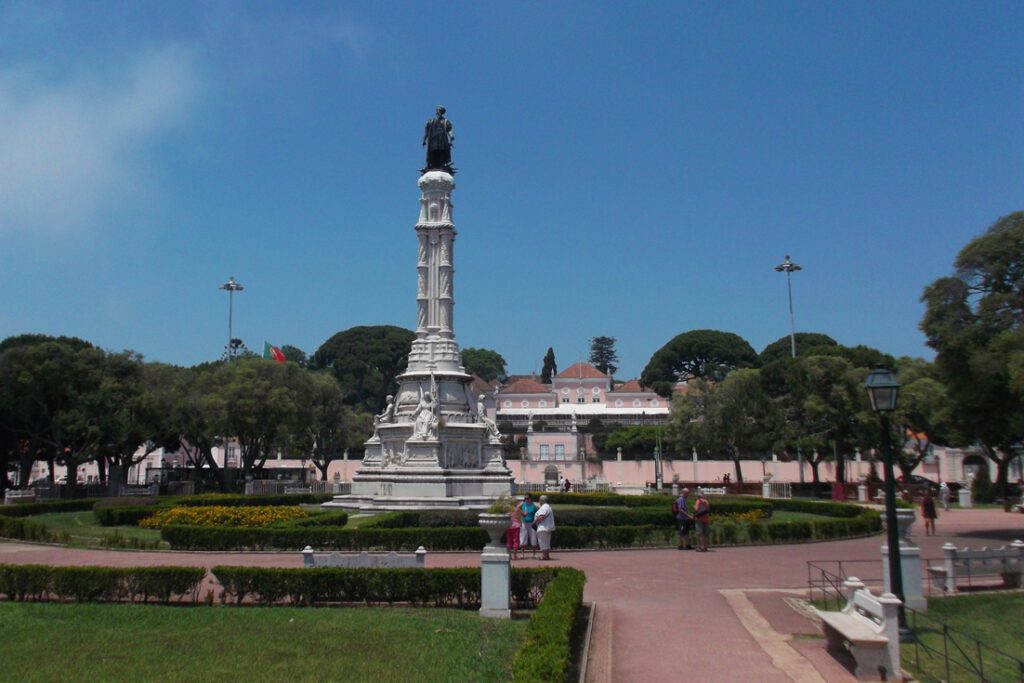
Around the Jardim Alfonso de Albuquerque
There are two interesting museums in this manicured garden. Museu Nacional dos Coches, the coach museum, and the Museu Presidencia da República.

(Photo: Geerd-Olaf Freyer from Aachen, Deutschland, Museu Nacional dos Coches (4904043960), cropped to 1102×735, CC BY-SA 2.0)
Museu Nacional dos Coches
Avenida da Índia 136
1300-300 Lisbon
Phone: + 351 – 210 – 732 319
Email: geral@mncoches.dgpc.pt
Open Tuesday to Sunday 10 a.m. to 5.30 p.m.

(Photo: Therese C, Museu da Presidência da República (1) – Jul 2008, cropped to 1102×735, CC BY 2.0)
Museu Presidencia da Republica
Palácio de Belém
Praça Afonso de Albuquerque
1349-022 Lisbon
Phone: + 351 – 213 614 660
Email: museu@presidencia.pt
Open Tuesday to Sunday from 10 a.m. to 6 p.m.
Walking from the Presidencia da República towards the most glorious of Belem’s sights, Monasterio do Jeronimo, the Jeronimo Monastery, don’t miss the pastry shop Pastéis de Belém.

Actually, usually, you cannot miss it since there is a very long queue of people waiting for their turn to sample the world-famous – and heavenly delicious – Natas, Portugal’s most iconic cupcakes.
Monasterio do Jeronimo
After a majestic snack, an even more majestic building: The Praca do Imperio is crowned by the huge, white, and lavishly decorated building, the Monasterio do Jeronimo.
The church and the monastery were commissioned by Manuel I around 1459 on the site of an older church. This, by the way, is very customary in Portugal. They also have an excellent exhibition on Portugal’s history in relation to these houses of worship.

The church’s ground floor can be visited for free – here is also Vasca da Gama’s tomb., To visit the upper part, you need a ticket since it’s only accessible through the monastery.
Visiting the monastery is worth every cent, and it’s worth the wait – yet you can cut the lines a bit by getting there either really early or rather late, at around 5 p. m. since that’s when the groups are gone.
Before you continue your walk through Belém, make sure to take a good look at the outer facade of the Santa Maria de Belém church, designed by Boytac and located on the monastery’s east corner facing the river.
On the monastery’s west side, the Museu de Marinha, dealing with maritime matters, as well as the Planetario Calouste Goulbenkian, can be visited.
The League of Generous Gentlemen
This planetarium was named after the great businessman and philanthropist who also founded the Calouste Goulbenkian Collection located in the neighborhood of the Praça da Espanha in Lisbon.
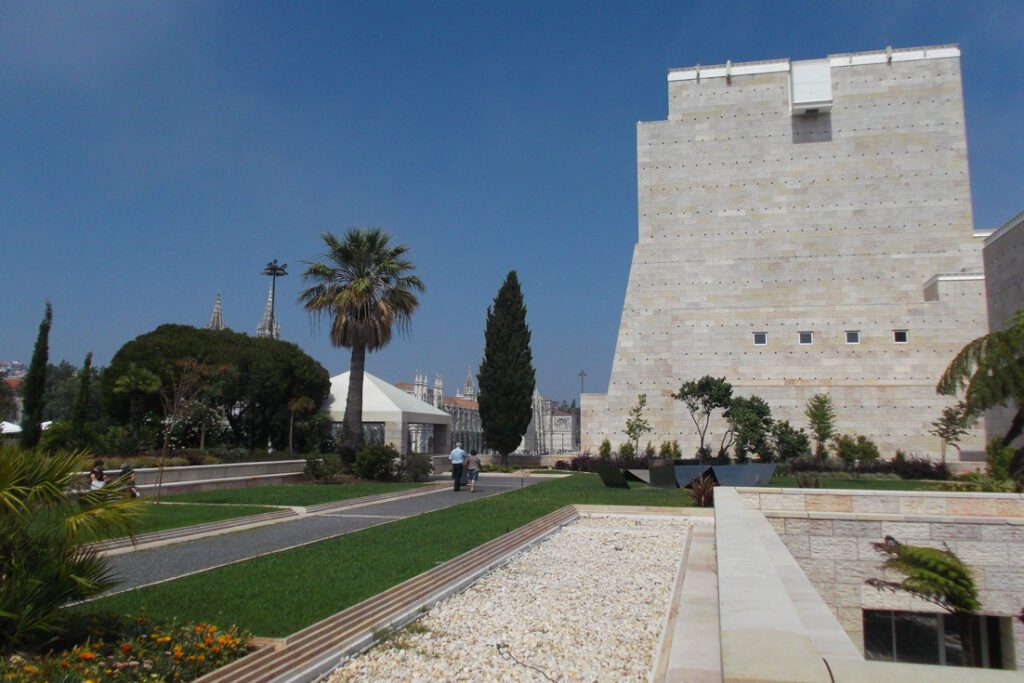
Another wealthy do-gooder was businessman and art collector José Manuel Rodrigues Berardo, who donated his impressive collection of modern art to the Museu Coleção Berardo.
Today, it can be visited on the premises of the Centro Cultural de Belém, the Cultural Center, presenting also other arts such as concerts and spectacles. Amazingly, on Saturdays, the entrance is free.
Museu Coleção Berardo
Praça do Império
1449-003 Lisboa
Phone: + 351 – 213 612 878
Open daily from 10 a.m. to 7 p.m. – and the entrance is free on Saturdays!
After you’ve seen this venue, do you think that’s it when it comes to art in Belém? Well, you stand so corrected!
Albeit, on the same side of the road is the Centro de Arqueologia de Lisboa, Lisbon Archeology Center, and the Galeria Avenida da Índia, worth a visit if you are into the alternative art scene.
Centro de Arqueologia de Lisboa
Avenida da Índia 166
Lisboa
Phone: + 351 – 218 172 180
Email: centro.arqueologia@cm-lisboa.pt
Torre de Belém
To cross to the southern side of the Avenidas, you either have to walk all the way back to the Jardim da Praca do Imperio, the one with the huge fountain.
Or you keep walking to the next bridge that crosses at the Jardim de Torre de Belém, the park adjacent to the famous Belém tower.
The tower was built on a basaltic outcropping of rocks in the Tagus River, so to this date, you can walk through the mud and across the slippery stones halfway around, which is popular with all those notorious Instagrammers.
The tower can be visited and climbed – and keep also in mind that there is a combo-ticket that grants you access to the monastery, too.
Further west behind the Jardim is another museum, the Museu do Combatante, dealing with all the supposedly heroic actions of the Portuguese – a topic I’m not really fond of.

(Photo: xiquinhosilva from Cacau, Forte do Bom Sucesso 33125-Lisbon (36302532896), cropped to 1102×735, CC BY 2.0)
Back to Lisbon
Tired now? If you keep walking west for about one mile, you’ll get to the Algés station. From here, you can take the regional train back to Lisbon. Or you hit the Praia de Algés for a while, Algés’ small yet nice beach on the river Tagus.
But don’t think you’ve seen it all – you are still missing one of the most popular sights in Belém, the Padrao dos Descobrimentos, a picture that shouldn’t be missing in any Portugal photo album. This landmark, too, can be accessed.
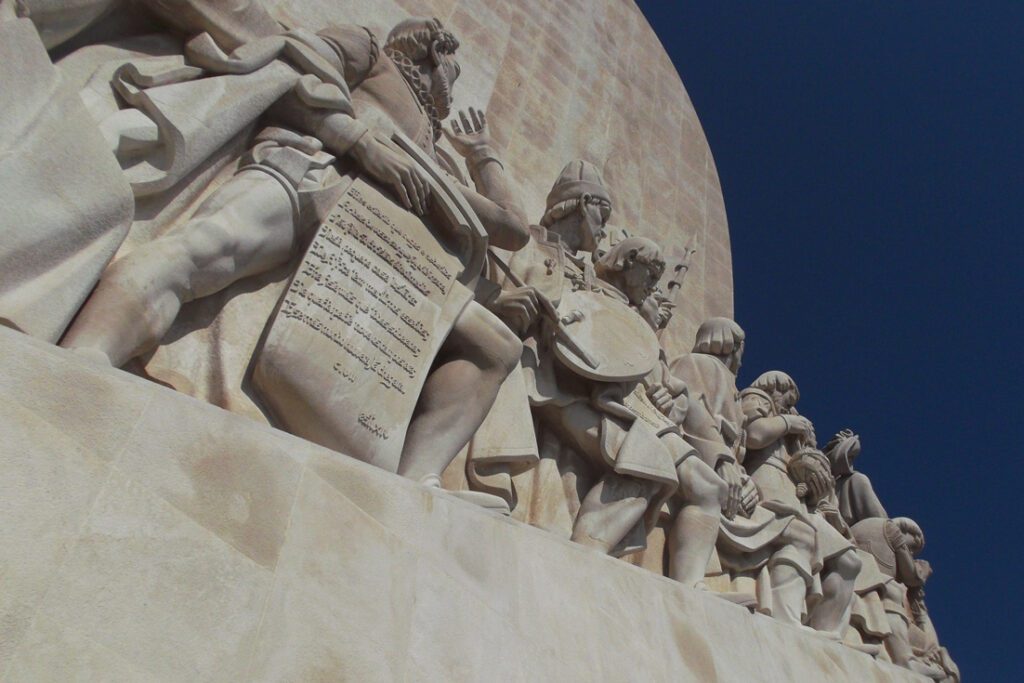
How to Get There
There are many different possibilities of how to get from Lisbon’s city center to Belém.
For instance, right from the Praça do Comércio, tram #15 takes you there in about half an hour.
Another option is taking the regional train Linha de Cascais, which is going to – you probably guessed so – Cascais via Belém and eventually Estoril.

Mind you, there are three major train stations in Lisbon. The one from where you are leaving westwards and up the Atlantic coast is called Cais do Sodré and is located west of the city center.
Belém was only one of many beautiful places I’ve visited in Portugal. So to read about the others, go to the main post and take your pick! You’ll also find all kinds of practical travel information there that will make your Portugal trip smooth and enjoyable.
Pinnable Pictures
If you choose to pin this post for later, please use one of these pictures:



Note: I’m completing, editing, and updating this post regularly – last in September 2025.
Did You Enjoy This Post? Then You Might Also Like These:
Best Street Art in PORTO
24 hours in LISBON
24 hours in PORTO
Railroad Trip PORTUGAL
Guide to FIGUEIRA da FOZ – a Charmingly Old Fashioned Seaside Resort
FAIAL – the Most Beautiful Island of the Azores
A Day in Sophisticated ESTORIL and CASCAIS
Best Street Art in LISBON – Part II: Marvila
*This is an affiliate link, obviously. If you book through this page, not only do you get the best deal, I also get a small commission that helps me run this blog. Thank you so much for supporting me! I was very lucky to be supplied with a 72hrs-Lisbon-Card by Turismo de Lisboa. However, all opinions on these services are mine and weren’t by any means influenced by my cooperation partner.
